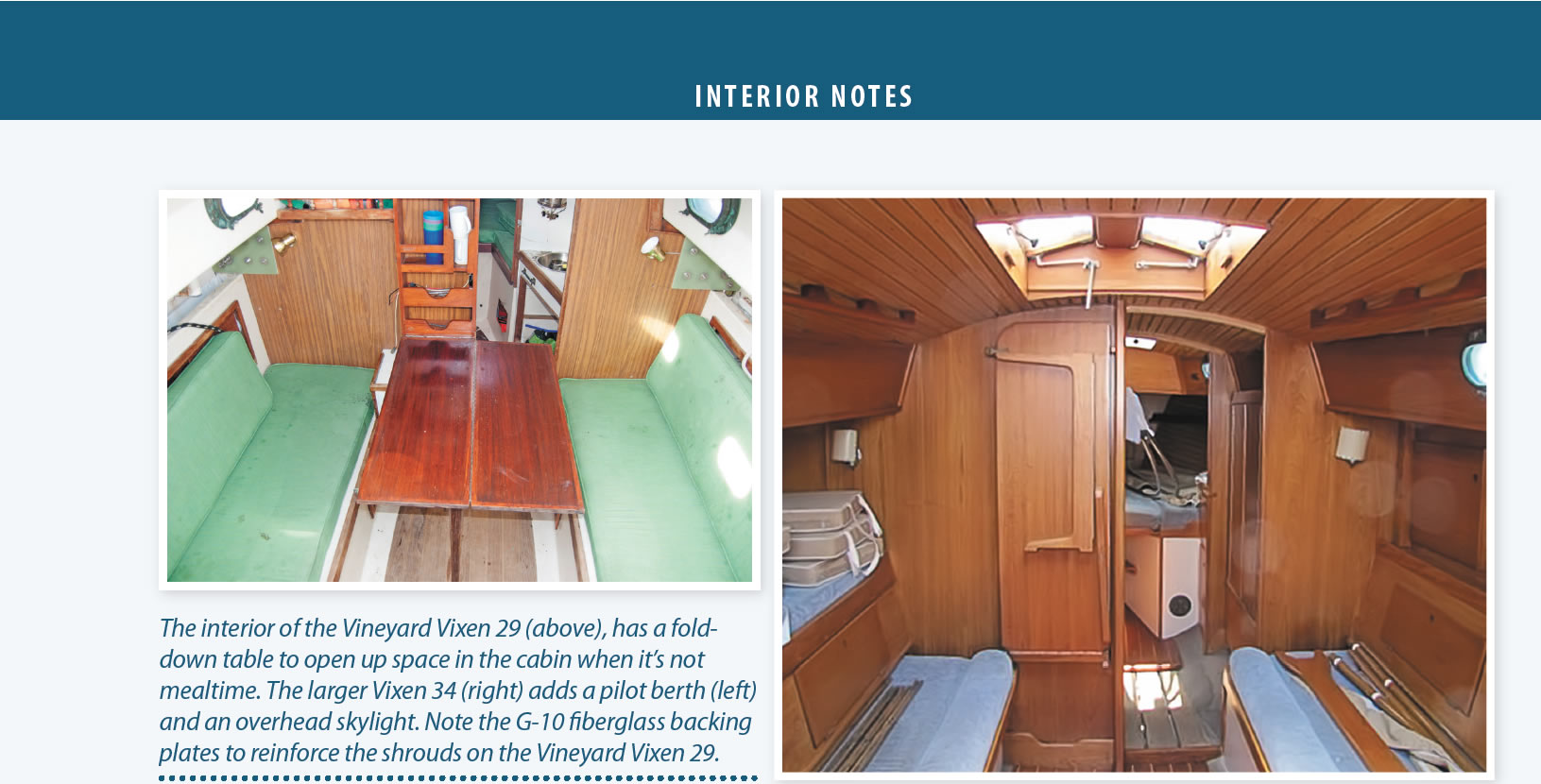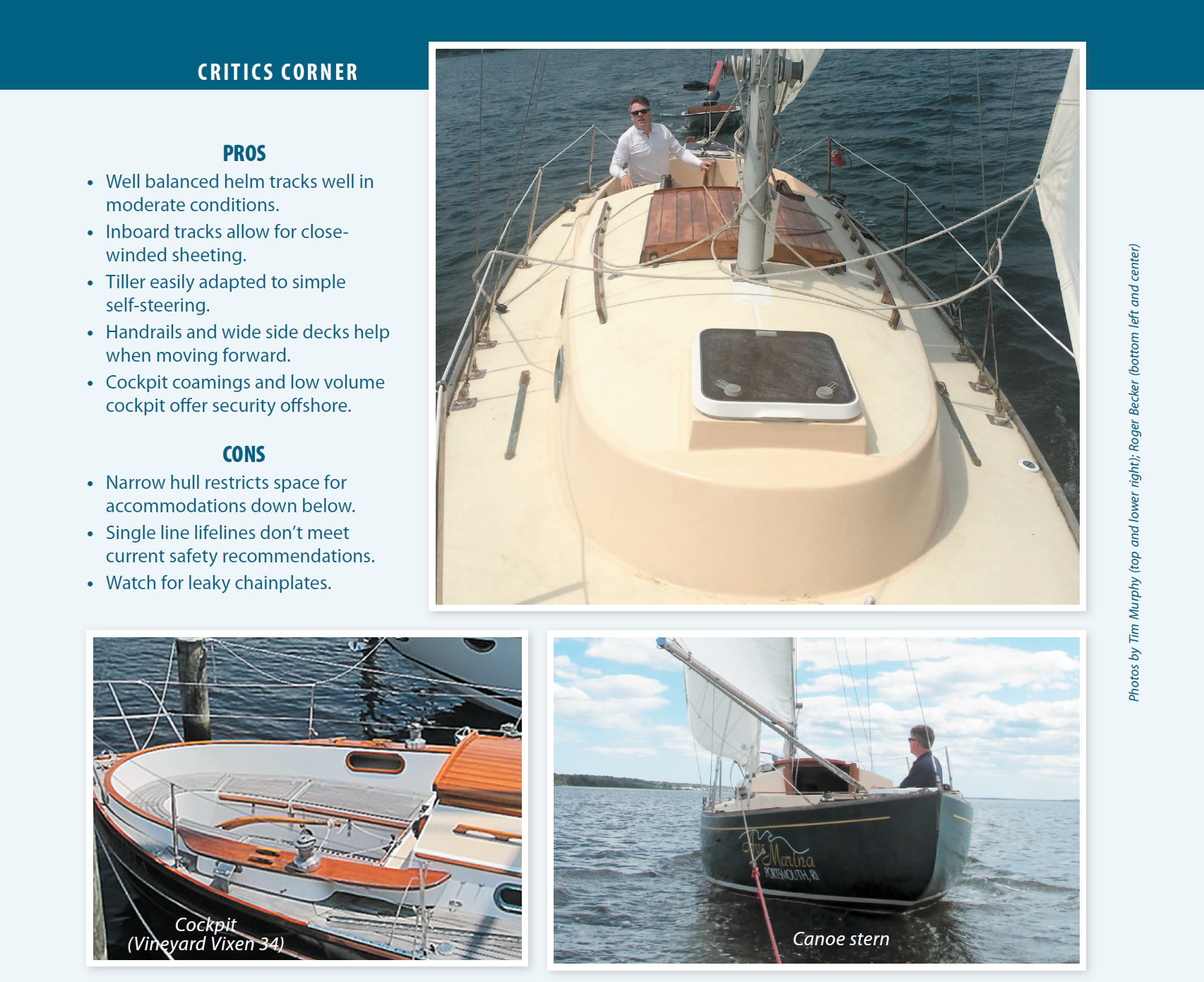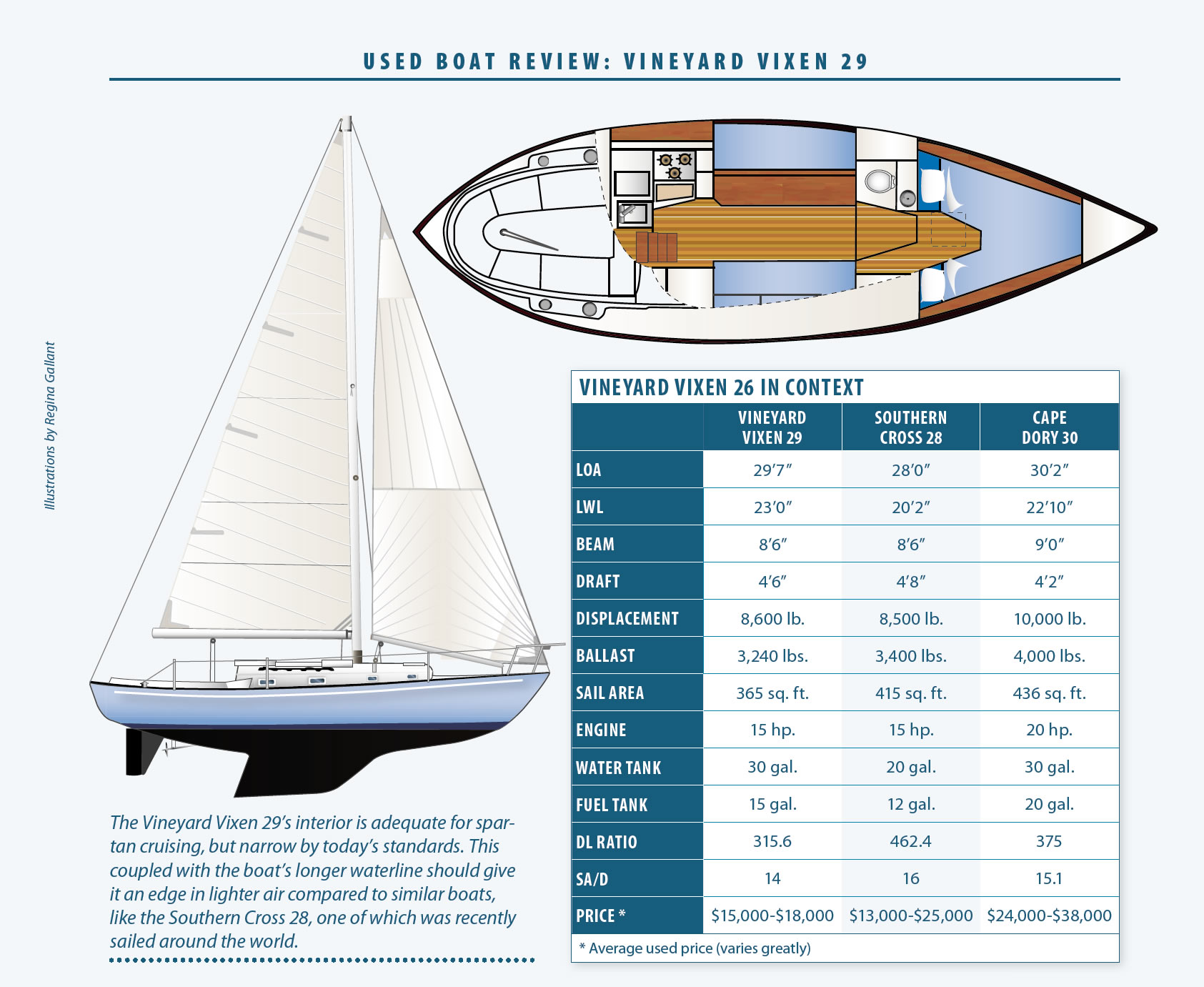The Vineyard Vixen 29 was born of another time-a fact that confers upon her some limits, yes, but also an undeniable magic. She is a canoe-stern monohull, 23 feet on the waterline and usually sloop-rigged, that arguably delivers as seakindly a sailing experience as any vessel of her size. While her cabin may edge over toward the camping side of the comfort continuum, her cockpit is more spacious and accommodating than that of some 40-footers, including Passports and Valiants. And while she wont be the first on the course to get going in light air, once the breeze is up past 8 or 10, the Vixens romp is incomparable.

Design
Tom Hale Sr. was a Harvard-educated architect with saltwater in his veins. Having moved to Marthas Vineyard in 1961 and purchased the then-100-year-old Marthas Vineyard Shipyard business, he wanted to create not land-bound structures but boats. He started by building wooden Noank sloops and Vineyard Haven 15s, and even adapted a lobster boat into an early picnic boat before moving on to bigger things.
I would say it was the 1972 Newport Boat Show, recalls Marthas Vineyard Shipyard president Phil Hale. My dad came back and said, I can design and build a better boat than the stuff I see there. And so he set out to create a good, stout little sailboat. The result was a run of 30 Vineyard Vixen 29s between 1973 and 1986-as well as 23 34-footers on similar lines.
The evolution of yacht design follows a fickle line. In Arthur Beisers second edition of The Proper Yacht, published in 1978, the author aired some personal grievances regarding newfangled trends, including this comment on the proper displacement for an ocean sailboat: C. William Lapworth feels that a displacement-length ratio of 250 or so represents medium displacement for a length of 30 or 35 feet and that anything over 350 is excessively heavy. I think most designers would consider a ratio of 250 to correspond to a light-displacement boat, and to call such a vessel anything else is to confuse the issue unnecessarily.

The patsy in Beisers argument was Bill Lapworth, the venerable designer of the now-venerable Cal 40 (1996 inductee to the American Sailboat Hall of Fame) and father of the split underbody. Whose argument prevailed? Consider that the latest fleet of new monohull cruising sailboats came to the 2016 boatshows with a median D/L of 160. The heaviest boat per length in Cruising Worlds 2017 Boat of the Year contest was the Germn Frers-designed Hallberg-Rassy 40 Mk III, that most proper of bluewater yachts, whose D/L tallies up to a whopping . . . 227.
How our tastes do change.
The Vineyard Vixen 29 was born of the mindset represented by Beisers side in that debate. Coming in at 8,600 pounds on a 23-foot waterline (D/L: 316) theres no contesting that the Vixen is conservative today. In fact, Tom Hales 1972 design was based on multiple influences, beginning with a boat thats older still: L. Francis Herreshoffs midcentury Design No. 98, Rozinante. And while Rozinante, in turn, was based on canoe yawls of the late 19th century, Tom Hales Vineyard Vixen took the double-ender premise into different waters.
For one thing, Hale adopted the split underbody-separating the keel from the skeg and rudder-that in Lapworths 1963 Cal 40 had caused so much controversy. By todays standards, that skeg offers oodles of protection compared to the more ubiquitous high-aspect-ratio spade rudders that are utterly unprotected.
He also increased the volume significantly.
Rozinante didnt have quite enough interior space, said Phil, so he changed that in his design. Tom Hales changes included standing headroom in the main saloon and a solid fiberglass pan (or liner) construction, with one liner at the sole and another under the deck. In the main saloon, the liner is a single FRP part that comprises the settee backs, the settees, and the sole.
Interior
The result is a very traditional layout. The main saloon features bench-style settees port and starboard, with a folding dinette table that stores on the main bulkhead-out of the way when not in use, and revealing a locker for dishes and cups when deployed. Forward of the bulkhead is a small area with ducking headroom: head to port, sink to starboard. The V-berth is forward of a secondary bulkhead, and a small rode locker occupies the extreme stem end of the interior. Engine, tankage, and batteries live under the cockpit, where theres also ample space for three sails. A small but deep lazarette occupies the pinched volume aft of the cockpit, allowing ample room for fenders and a swim ladder.
Between the interior fiberglass liner and the hull, there is no access, but there is a space of two inches or so. A deep keel sump in the machinery space just aft of the companionway, and aft of the liner, is the only place to see what water has come aboard. A seasonal swishing of bleach solution into the bilge from the V-berth (forward of the liner) keeps mildew at bay.
The Vixens galley is aft under the companionway-or, in some cases, competing with it. Space here is tight; the sink on centerline drains just above the propulsion engine installed below.
The mast is deck-stepped, with a solid beam incorporated into the main bulkhead to take the compression loads. Three sets of shrouds (an upper and two lowers) terminate at chainplates port and starboard inset in the sidedecks. These need to be rebedded occasionally to prevent water intrusion and eventual damage to the bulkhead or hanging knees that support the chainplate.
Hatches at the companionway, as well as forward and at the lazarette, were built of wood by the yard. Some owners have replaced these with standard Lewmar hatches, but doing so requires some work to rebuild the boss against which the hatch seals.
Nearly all of the 29s were designed and built as sloops. But two or three went out as yawls, says Phil.
Throughout the series is a deeply held appreciation for the aesthetic experience of boats in their environment. There are only two straight lines on a boat, the mast and the waterline, Tom Hale wrote in The Vineyard Gazette several years before his death in 2012 at age 87. The rest is a symphony of complementary curves reflecting and responding to the boats two natural elements-the wind and the water.
The Vineyard Vixen was designed by a man with an eye for such symphonies.

Construction
In 1973, Tom Hale was operating in the early heyday of
building with fiberglass-reinforced plastics. Construction of the 29 reflects the ethos of that time: three layers of alternating fiberglass woven roving and mat above the waterline; four layers below the water; and five layers around the keel-all in a matrix of polyester resin and employing no core in the hull. For production boatbuilders of that time, woven roving represented the state of the art. Much heavier than fiberglass cloth, roving gently revolutionized building practices, as it demanded fewer plies in the laminate and significantly reduced labor hours in every boat. The downside is that its broad weave invites more resin into the spaces, rendering a heavier part.
As such, the Vineyard Vixen falls in a historical middle zone in the evolution of composite construction. Before her came the boatbuilders in FRP who relied heavily on chopped-strand mat and resin, mistaking mere thickness in the layup for strength and not yet savvy about the useless and brittle weight that comes with an excessively resin-rich laminate. After her came composite builders who more deftly exploited the smarter strength-to-weight ratios that could be achieved with such materials and techniques as sandwich construction, exotic fibers (S-glass, carbon, aramids), directional knitted fiberglass cloth (unidirectional, biaxial, triaxial), resins (vinylester, epoxy) and engineered foam coring.
The Hales did use core in the decks: plywood for the first 15 or so boats, then foam on subsequent boats. One boat, hull number six, suffered water intrusion through the chainplates and hatches-and sustained exactly zero damage to the hull and deck laminates where core had been blessedly avoided.
For a dozen years and more, the Hales worked with a winning formula, creating 53 Vineyard Vixen 29s and 34s that were lovely to behold and lovelier still to be aboard. But a macroeconomic shift in the late 1980s was tectonic, affecting not just Marthas Vineyard Shipyard but boatbuilders all over New England-Bristol Yacht Company, Cape Dory Yachts, C.E. Ryder Corporation, ODay Corporation, Pearson Yachts-and the rest of North Americas composite boatbuilders. Eyes wide open, the Hales saw the end before some others did.
We just couldnt do it economically, Tom told a Marthas Vineyard Magazine reporter in 2006. You could buy a similar boat almost as nicely finished in Taiwan, and that boat could be deck-shipped to San Francisco, loaded on a truck, taken to Newport, and rigged, and launched, and delivered-customs duties and the brokers fees paid-to the owner for less than we could build and deliver the same boat in Vineyard Haven harbor.
Tom Hale sold Marthas Vineyard Shipyard to his son Phil in 1986, and soon Phil shut down the building operation, focusing instead on high-quality service for boaters on Cape Cod and the nearby islands. Unlike some of those aforementioned boatbuilders, Marthas Vineyard Shipyard is still very much inbusiness.
Under Way
In the design comments, weve already mentioned the Vixens displacement-to-length ratio of 316-off the heavy side of the chart for todays new boats. Her skimpy 365 square feet of working sail tot up to a sail-area-to-displacement ratio of just 14, compared to a median of about 21 in todays new-boat fleet. The implications are that a similarly sized late-model cruising boat-say, a Beneteau 311 with a D/L of 152 and an SA/D of 19-will slip right by in a gentle zephyr.
But once the breeze is up over 10 knots or so, the Vixen will implicitly remind you that seakindliness is a function of displacement, particularly when that displacement is arranged in a hull form as lovely as this. Tie off her helm with a bit of shock cord from the sheet, and shell self-steer all day long with only minor adjustments-and no need for an autopilot. And in a seaway? Youve just got to try it for yourself to understand how that canoe stern behaves.
According to Phil Hale, the first 29s were delivered with four-cylinder Westerbekes. In some later models, the yard installed one-cylinder Volvos. None was fitted with an Atomic 4. Several have subsequently been refit with three-cylinder Yanmars. All deliver around 15 horsepower. The owner of hull number six removed the engine altogether and has sailed the boat engineless from a mooring-happily for more than 15 years. A 11-foot Boston Whaler serves as yawlboat for trips in and out of the boatyards at the beginning and end of the season.
Compare the way a Vineyard Vixen 29 answers her helm in a stiff breeze with a that of a late-model production cruiser whose transom was designed around a queen-sized aft cabin: youll remember why you liked sailing in the first place.
Conclusion
Despite the relatively small number of hulls made, Vixens often come onto the market. They have a cult-like following in New England and wouldnt be a bad investment for one with distant aspirations but in need of a training vessel-a boat that could, if called upon, take one as far as you want to go. Like any model from this era, boats on the used market will vary widely in condition. Although were unaware of any deal-breaking defects, be sure to have a qualified surveyor inspect the boat before buying.
For those who don’t mind paying a bit more for more room below, the Vineyard Vixen 34, featured here in some photos, is also worth a test sail.

The interior of the Vineyard Vixen 29 (above), has a fold-down table to open up space in the cabin when its not mealtime. The larger Vixen 34 (right) adds a pilot berth (left) and an overhead skylight. Note the G-10 fiberglass backing plates to reinforce the shrouds on the Vineyard Vixen 29.

Pros
-Well balanced helm tracks well in moderate conditions.
-Inboard tracks allow for close-winded sheeting.
-Tiller easily adapted to simple self-steering.
-Handrails and wide side decks help when moving forward.
-Cockpit coamings and low volume cockpit offer security offshore.
Cons
-Narrow hull restricts space for accommodations down below.
-Single line lifelines don’t meet current safety recommendations.
-Watch for leaky chainplates.

The Vineyard Vixen 29s interior is adequate for spartan cruising, but narrow by todays standards. This coupled with the boats longer waterline should give it an edge in lighter air compared to similar boats, like the Southern Cross 28, one of which was recently sailed around the world.

































